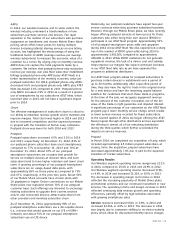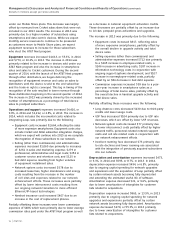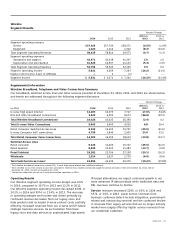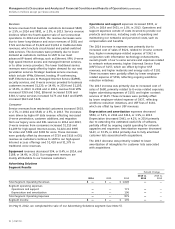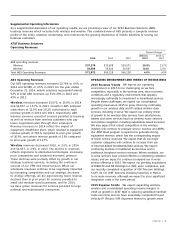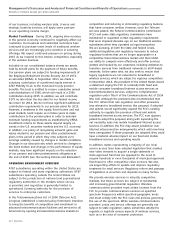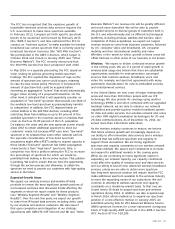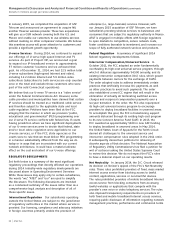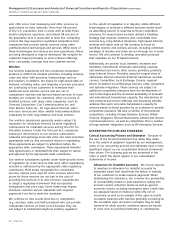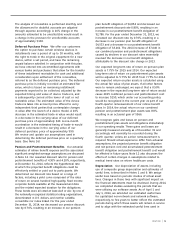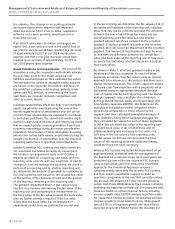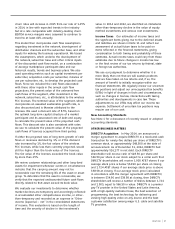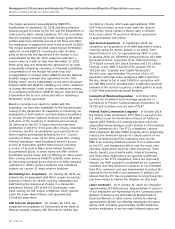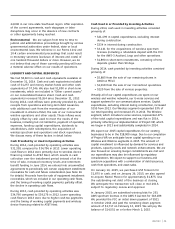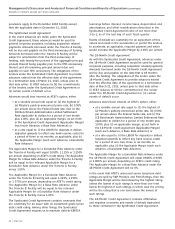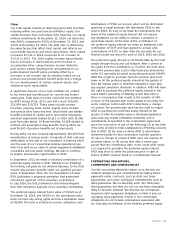AT&T Wireless 2014 Annual Report Download - page 27
Download and view the complete annual report
Please find page 27 of the 2014 AT&T Wireless annual report below. You can navigate through the pages in the report by either clicking on the pages listed below, or by using the keyword search tool below to find specific information within the annual report.
AT&T INC.
|
25
plan benefit obligation of $4,854 and decreased our
postretirement discount rate 0.80%, resulting in an
increase in our postretirement benefit obligation of
$2,786. For the year ended December 31, 2013, we
increased our discount rate by 0.70%, resulting in a
decrease in our pension plan benefit obligation of
$4,533 and a decrease in our postretirement benefit
obligation of $3,161. The 2014 increase of $7,640 in
our combined pension and postretirement obligations
caused by declines in our discount rates essentially
reversed the decrease in our benefit obligation
attributable to the discount rate change in 2013.
Our expected long-term rate of return on pension plan
assets is 7.75% for 2015 and 2014. Our expected
long-term rate of return on postretirement plan assets
will be adjusted to 5.75% for 2015 from 7.75% for 2014.
Our expected return on plan assets is calculated using
the actual fair value of plan assets. If all other factors
were to remain unchanged, we expect that a 0.50%
decrease in the expected long-term rate of return would
cause 2015 combined pension and postretirement cost
to increase $250, which under our accounting policy
would be recognized in the current year as part of our
fourth-quarter remeasurement of our retiree benefit
plans. In 2014, the actual return on our combined
pension and postretirement plan assets was 8.8%,
resulting in an actuarial gain of $566.
We recognize gains and losses on pension and
postretirement plan assets and obligations immediately
in our operating results. These gains and losses are
generally measured annually as of December 31 and
accordingly will normally be recorded during the
fourth quarter, unless an earlier remeasurement is
required. Should actual experience differ from actuarial
assumptions, the projected pension benefit obligation
and net pension cost and accumulated postretirement
benefit obligation and postretirement benefit cost would
be affected in future years. Note 12 also discusses the
effects of certain changes in assumptions related to
medical trend rates on retiree healthcare costs.
Depreciation Our depreciation of assets, including
use of composite group depreciation and estimates of
useful lives, is described in Notes 1 and 6. We assign
useful lives based on periodic studies of actual asset
lives. Changes in those lives with significant impact on
the financial statements must be disclosed. During 2014,
we completed studies evaluating the periods that we
were utilizing our software assets. As of April 1 and
July 1, 2014, we extended our estimated useful lives
for capitalized non-network and network software,
respectively, to five years to better reflect the estimated
periods during which these assets will remain in service
and to align with the estimated useful lives used in
The analysis of receivables is performed monthly, and
the allowances for doubtful accounts are adjusted
through expense accordingly. A 10% change in the
amounts estimated to be uncollectible would result in
a change in the provision for uncollectible accounts
of approximately $100.
Deferred Purchase Price We offer our customers
the option to purchase certain wireless devices in
installments over a period of up to 30 months, with
the right to trade in the original equipment for a new
device, within a set period, and have the remaining
unpaid balance satisfied. In conjunction with this plan,
we have entered into uncommitted agreements with
various banks and purchasers that allow for the transfer
of these installment receivables for cash and additional
consideration upon settlement of the receivables,
referred to as the deferred purchase price. The deferred
purchase price is initially recorded at estimated fair
value, which is based on remaining installment
payments expected to be collected, adjusted by the
expected timing and value of device trade-ins, and
is subsequently carried at the lower of cost or net
realizable value. The estimated value of the device
trade-ins takes into account prices offered to us by
independent third parties that contemplate changes
in value after the launch of a device model. A 10%
decrease in the estimated trade-in value would result
in a decrease in the carrying value of our deferred
purchase price of approximately $40. A one-month
acceleration in the estimated timing of trade-in would
result in a decrease in the carrying value of our
deferred purchase price of approximately $90.
We review and update our assumptions used in
determining the deferred purchase price on a quarterly
basis. (See Note 16)
Pension and Postretirement Benefits Our actuarial
estimates of retiree benefit expense and the associated
significant weighted-average assumptions are discussed
in Note 12. Our assumed discount rate for pension and
postretirement benefits of 4.30% and 4.20%, respectively,
at December 31, 2014, reflects the hypothetical rate
at which the projected benefit obligations could be
effectively settled or paid out to participants. We
determined our discount rate based on a range of
factors, including a yield curve composed of the rates
of return on several hundred high-quality, fixed income
corporate bonds available at the measurement date
and the related expected duration for the obligations.
These bonds were all rated at least Aa3 or AA- by one of
the nationally recognized statistical rating organizations,
denominated in U.S. dollars, and neither callable,
convertible nor index linked. For the year ended
December 31, 2014, we decreased our pension discount
rate by 0.70%, resulting in an increase in our pension


